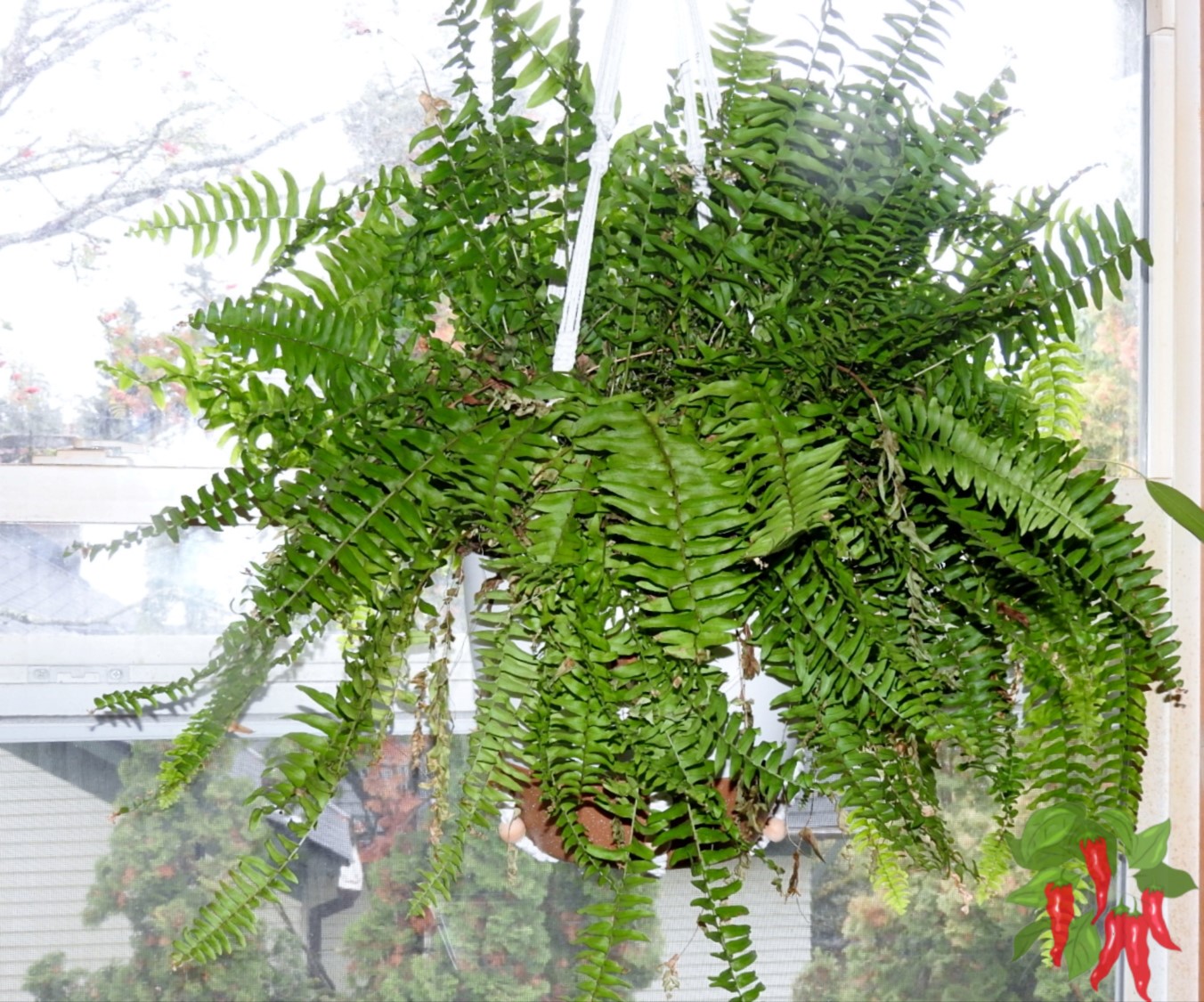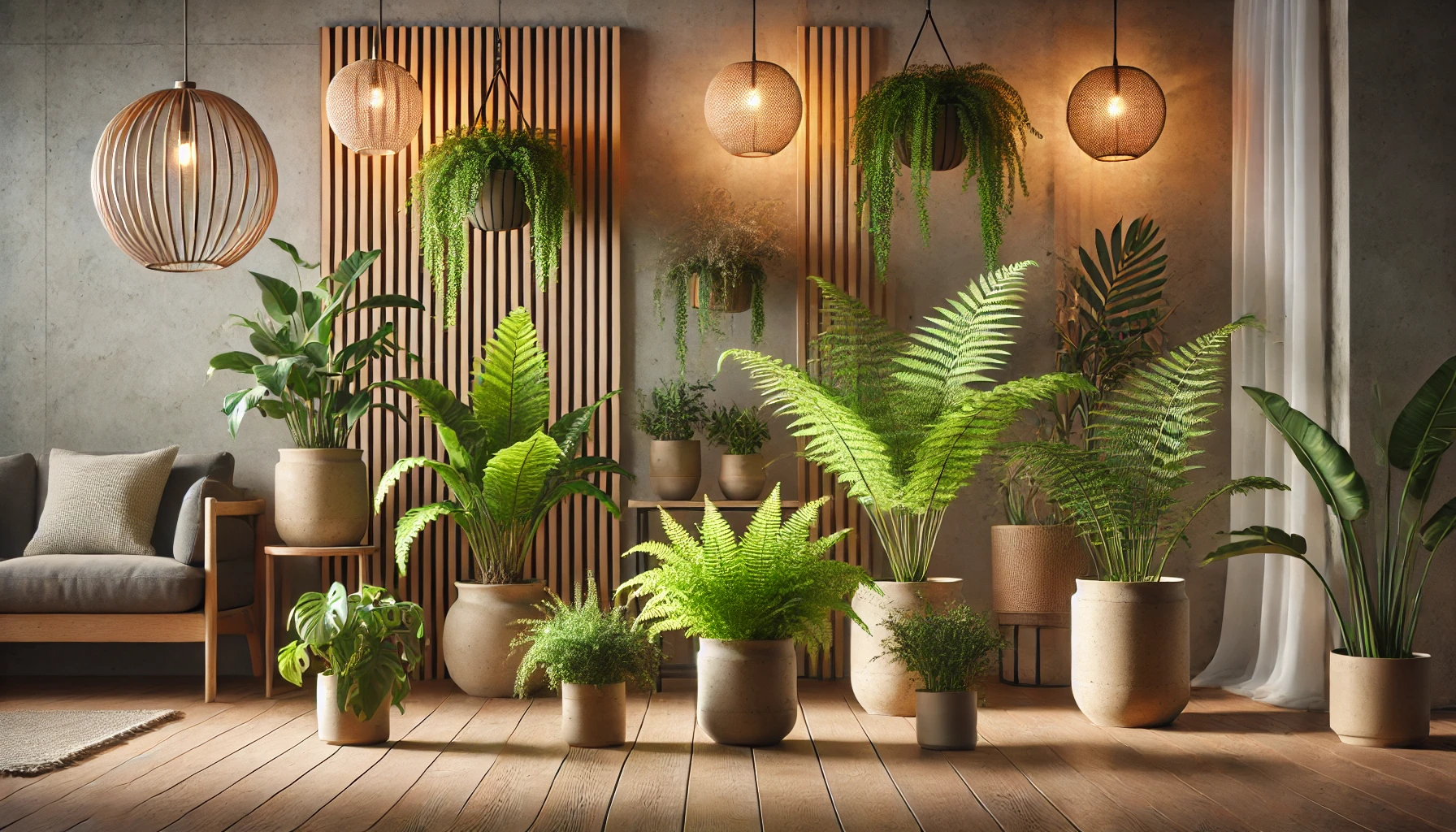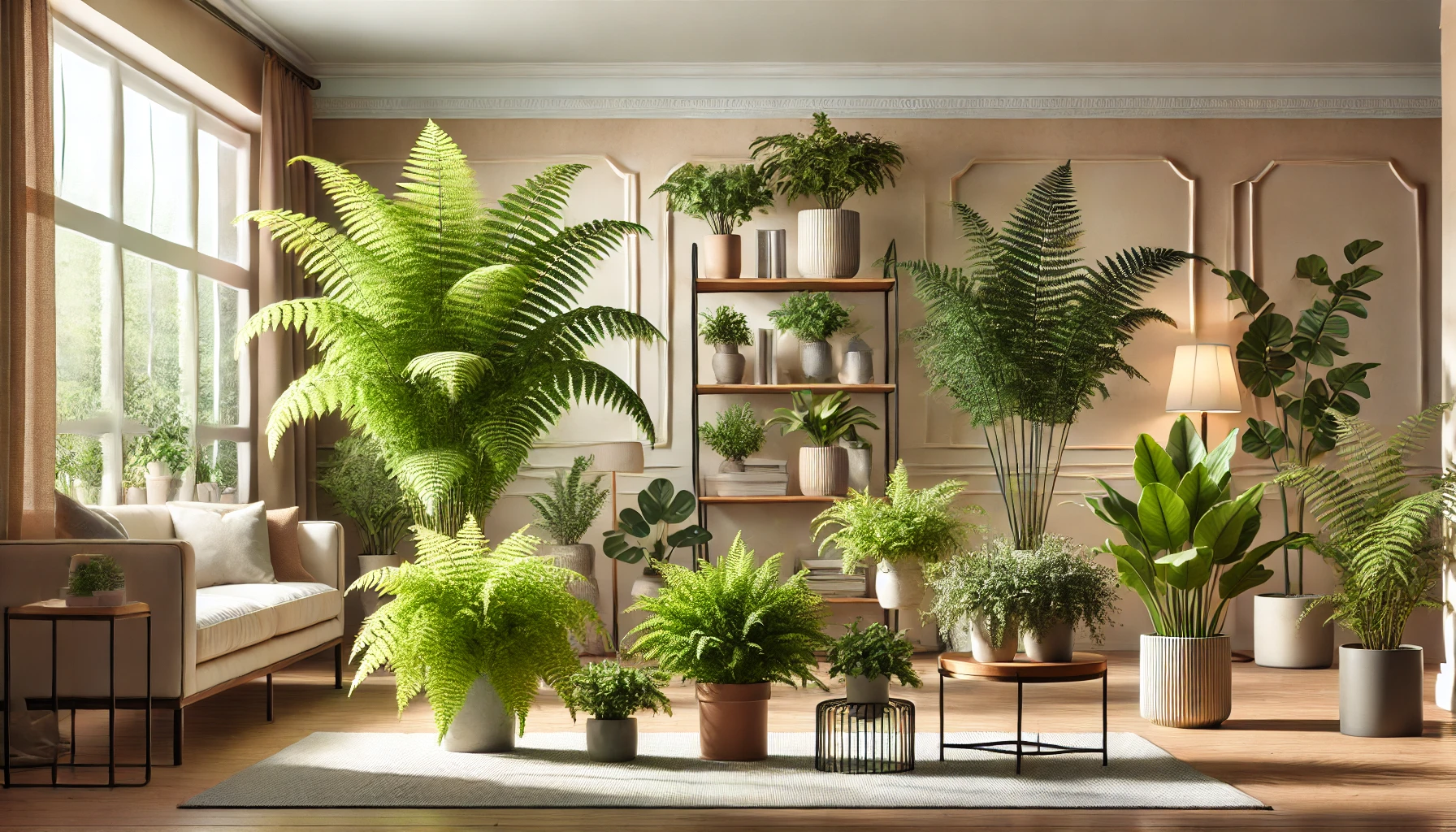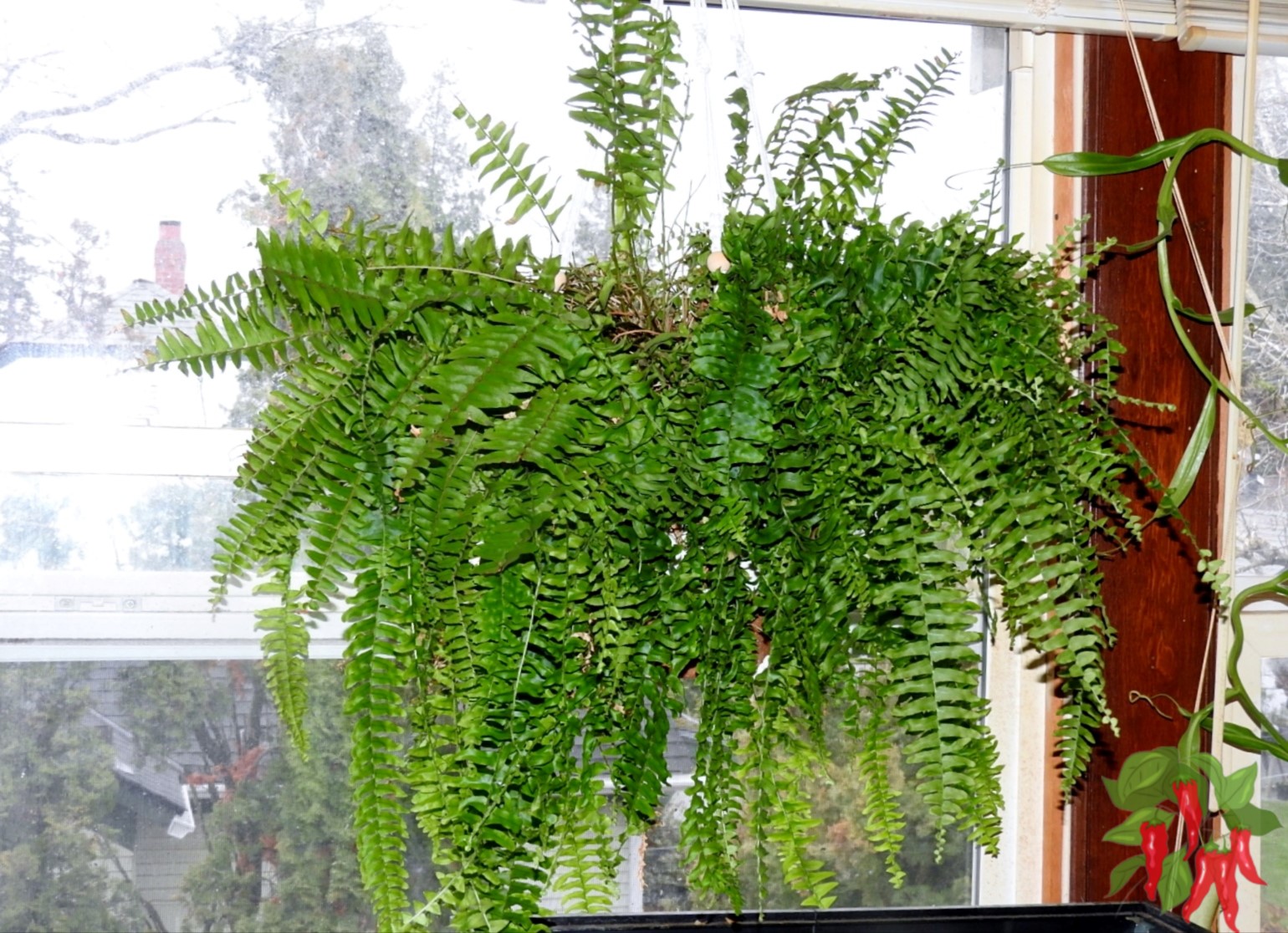This post contains affiliate links. If you buy something from one of our links we may earn a commission. Thanks
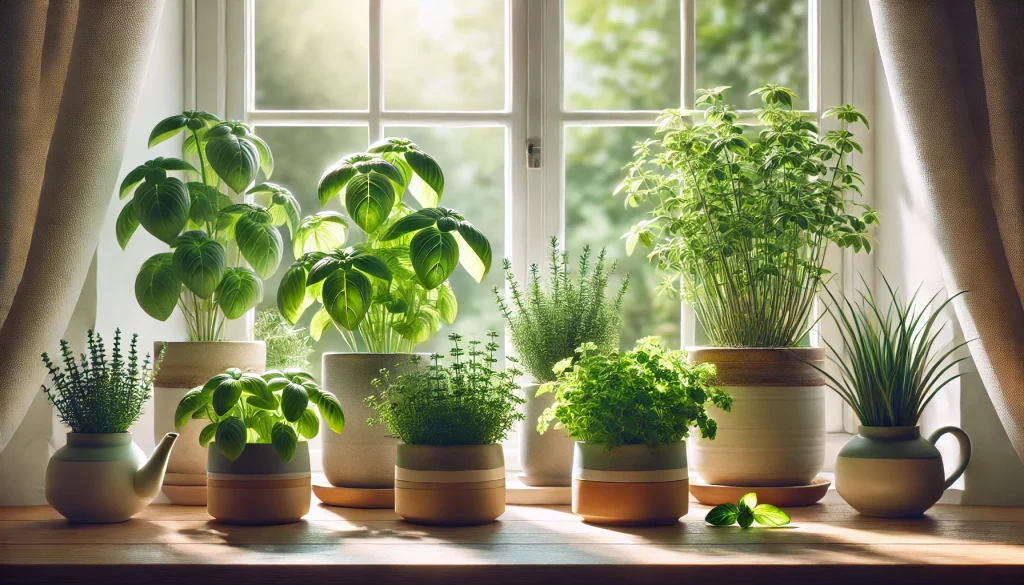
Grow fresh, flavorful herbs at home with ease! Indoor Herb Gardens bring greenery and taste to your kitchen all year round. Start your herb journey today!
Indoor Herb Gardens Key Takeaways
- Indoor Herb Gardens are a simple and rewarding way to grow fresh herbs indoors.
- They thrive in small spaces with proper light, water, and care.
- Perfect for beginners, herb gardens bring fresh flavors to your cooking.
- They add a touch of nature to your home while being easy to maintain year-round.
Indoor Herb Gardens & Growing Fresh Herbs
Indoor Herb Gardens are the perfect way to bring fresh flavors and greenery into your home all year round.
Struggling to find fresh herbs at the store? With an indoor setup, you’ll always have your favorite herbs within reach, thriving right in your kitchen or living space.
Let’s dive into how you can make it happen!
Indoor Herb Garden Kits the All-in-One Solution

9 Herb Indoor Window Garden Kit – House Plants Seeds – Best Unique Easter Gift Ideas for Women, Mom, Friend, Her, Birthday, Housewarming, Mother – New Home Kitchen Gifts – Live Plant Starter
Indoor Herb Garden Kits are a fantastic option for anyone looking to grow fresh herbs with ease.
These all-in-one solutions are designed to make herb gardening simple and accessible, no matter your experience level or available space.
Whether you’re a beginner or an experienced gardener, these kits offer convenience and results.
Benefits of Indoor Herb Garden Kits
- Convenience: Kits often include everything you need—seeds, soil, pots, and instructions.
- Beginner-Friendly: Perfect for those new to gardening who want an easy start.
- Compact Design: Many kits are small and stylish, fitting perfectly on a kitchen counter or windowsill.
- Year-Round Gardening: With options like hydroponic systems and grow lights, you can grow fresh herbs any time of year.
Popular Types of Kits
- Starter Kits: Simple kits with seeds, pots, and soil—great for beginners.
- Hydroponic Systems: Soil-free kits that use water and nutrients, often with built-in grow lights.
- Smart Kits: High-tech options with automated watering, lighting, and nutrient systems for hassle-free gardening.
Tips for Choosing the Right Kit
- Space Available: Consider where you’ll place the kit and ensure it fits your space.
- Herbs You’ll Use: Select a kit with herbs you frequently cook with, like basil, parsley, or thyme.
- Maintenance Level: Opt for a kit that matches your care preferences, from low-maintenance hydroponic setups to hands-on traditional kits.
Best Features to Look For
- Pots with drainage for healthy root growth.
- LED grow lights for herbs grown in low-light areas.
- High-quality seeds for reliable germination.
- Reusable components for sustainable gardening.
Indoor Herb Garden Kits are a perfect way to enjoy fresh, flavorful herbs without the hassle of starting from scratch.
They’re ideal for anyone looking for a convenient, compact, and rewarding gardening experience!
Indoor Herb Gardens: Fresh, Flavorful, and Easy to Grow
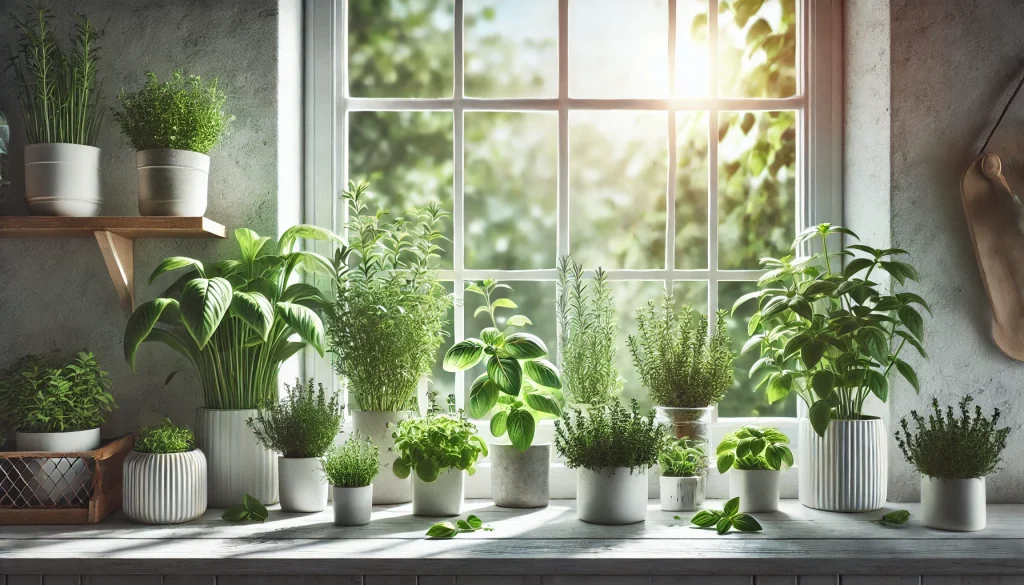
Indoor Herb Gardens are a perfect way to bring fresh greenery and flavor into your home, no matter your space or experience level.
From beginners looking to grow their first basil plant to seasoned gardeners exploring hydroponic setups, indoor herb gardening offers something for everyone.
With benefits like year-round harvests, improved air quality, and easy access to fresh herbs for cooking, it’s no wonder these gardens are growing in popularity.
In this guide, we’ll explore everything from the best herbs to grow indoors to DIY tips, lighting options, and troubleshooting common challenges. Let’s get started on your indoor herb garden journey!
Section 1: Why Grow Herbs Indoors?
Indoor Herb Gardens offer more than just a touch of greenery—they bring fresh flavors to your meals, improve air quality, and create a calming atmosphere.
Growing herbs indoors means no waiting for the right season and no worrying about outdoor pests or weather conditions.
Whether you’re looking to save money on store-bought herbs, experiment with DIY gardening, or enjoy the therapeutic benefits of nurturing plants, indoor herb gardening is a convenient and rewarding hobby.
Let’s dive into why so many people are choosing to grow their own herbs indoors!
Benefits of Indoor Herb Gardens
Indoor Herb Gardens are more than just a hobby—they offer a variety of benefits that enhance your health, environment, and culinary experiences.
Whether you’re a home chef or someone looking to add a little green to your life, growing herbs indoors brings unique advantages.
Health Benefits
- Improved Air Quality: Many herbs, like mint and rosemary, naturally purify the air in your home.
- Stress Relief: Caring for plants has been shown to reduce stress and boost mood.
- Freshness at Your Fingertips: Enjoy nutrient-rich herbs straight from your garden, enhancing the flavor and healthiness of your meals.
Environmental Benefits
- Reduced Waste: Grow only what you need, reducing food waste from unused store-bought herbs.
- Lower Carbon Footprint: Skip the plastic packaging and transportation impact of store-bought herbs.
- Sustainable Options: Use eco-friendly gardening methods like organic soil and reusable planters.
Culinary Benefits
- Year-Round Harvests: Always have fresh herbs like basil, parsley, or thyme ready for cooking.
- Enhanced Flavors: Freshly picked herbs elevate the taste of homemade meals, sauces, and drinks.
- Cost Savings: Growing your own herbs is more affordable than buying them regularly.
Indoor Herb Gardens combine practicality with enjoyment, making them a fantastic addition to any home!
Section 2: Getting Started
Starting your Indoor Herb Garden is simple and rewarding. With the right herbs, tools, and setup, you can enjoy fresh flavors year-round.
Whether you’re a beginner or refreshing your gardening skills, this section will guide you through everything needed to get started and create a thriving, vibrant herb garden indoors.
Indoor Herb Gardens for Beginners
Starting your first Indoor Herb Garden is exciting and easier than you might think!
All you need is a little space, some sunlight, and the right plants to get growing.
In this beginner-friendly guide, we’ll cover the basics to help you grow fresh, flavorful herbs with confidence.
Key Steps for Beginners
- Choose Easy-to-Grow Herbs: Basil, mint, and parsley are beginner favorites.
- Pick the Right Spot: Find a location with enough sunlight or invest in a grow light.
- Start Small: Focus on 2-3 herbs to get started and expand as you gain confidence.
- Use Proper Containers: Choose pots with drainage holes to prevent waterlogged roots.
- Be Consistent: Water regularly, but don’t overdo it—check soil moisture first.
Essential Tools for Indoor Herb Gardening
Having the right tools can make your Indoor Herb Garden journey smooth and enjoyable.
You don’t need much to start, but a few essentials can set you up for success and healthier plants.
Must-Have Tools
- Pots with Drainage Holes: Prevent overwatering and root rot.
- Potting Mix: Use a well-draining mix like coco coir and perlite.
- Watering Can: A small one with a narrow spout offers better control.
- Grow Lights: Essential if your space lacks natural sunlight.
- Pruning Shears: Keep plants healthy by trimming leaves and stems.
Optional but Helpful: A humidity tray, plant labels, and a pH meter for soil testing.
Best Herbs for Indoor Growing
Not all herbs thrive indoors, but some are perfectly suited for indoor gardening. These resilient, flavorful options make a great starting point for your Indoor Herb Garden.
Top Herbs to Grow Indoors
- Basil: Loves warmth and bright light—perfect for sunny windows.
- Mint: Grows quickly and tolerates lower light levels.
- Thyme: A versatile herb that thrives in sunny, dry conditions.
- Parsley: Adapts well to partial sunlight and regular watering.
- Chives: Low maintenance and a great addition to many dishes.
Tips for Success
- Group herbs with similar light and water needs together.
- Rotate pots regularly for even growth.
- Harvest often to encourage healthy regrowth.
With the right tools and herb choices, you’re well on your way to creating a lush, flavorful indoor herb garden!
Section 3: Setting Up Your Indoor Herb Garden
Creating your Indoor Herb Garden is an exciting step toward enjoying fresh herbs at home. Setting it up correctly ensures your plants thrive, no matter the season or space available.
This section will guide you through the setup process, from choosing the perfect location to preparing pots and soil, making it simple and stress-free!
Setting Up an Indoor Herb Garden
Setting up your Indoor Herb Garden is simple and rewarding with the right steps.
A well-prepared space will help your herbs grow lush and healthy, giving you fresh flavors all year round.
Follow these easy instructions to get started on your indoor gardening journey.
Step-by-Step Instructions
- Choose the Right Location: Find a spot with at least 6 hours of sunlight or add a grow light.
- Pick Your Herbs: Start with beginner-friendly choices like basil, mint, or parsley.
- Select Containers: Use pots with drainage holes to prevent waterlogging.
- Prepare the Soil: Use a well-draining potting mix like coco coir and perlite.
- Plant and Water: Plant your herbs, water them lightly, and place them in their new home.
Indoor Herb Garden Setup: Easy Steps for Herb Garden Success
Light Requirements for Indoor Herb Gardens
Light is essential for thriving Indoor Herb Gardens. Whether you rely on natural sunlight or opt for artificial grow lights, understanding your plants’ needs will ensure success.
Natural vs. Artificial Light
- Natural Light: South-facing windows are ideal for herbs needing bright, indirect sunlight.
- Artificial Light: Grow lights are a great solution for low-light spaces or cloudy seasons.
Tips for Optimal Lighting
- Place grow lights 6-12 inches above your plants.
- Rotate pots weekly to promote even growth.
- Use a timer for grow lights to simulate 10-12 hours of sunlight.
Soil and Fertilizer for Indoor Herbs
The right soil and fertilizer are key to keeping your Indoor Herb Garden healthy and productive. With the proper mix and nutrients, your herbs will flourish indoors.
Best Practices for Soil
- Use a light, well-draining potting mix like a 70%coco coir and 30% perlite mix.
- Mix in organic compost or worm castings for added nutrients.
- Avoid heavy garden soil, which can compact and restrict roots.
Fertilizer Tips
- Use an organic liquid fertilizer every 4-6 weeks during active growth.
- Avoid over-fertilizing, which can lead to leggy, weak plants.
Watering Techniques for Indoor Herbs
Watering your Indoor Herb Garden might seem simple, but it’s easy to overdo or underdo it. The right technique will keep your herbs thriving without the risk of root rot.
Tips for Watering
- Check the Soil: Water when the top inch of soil feels dry to the touch.
- Drain Excess Water: Always empty the saucer under your pots to avoid soggy roots.
- Know Your Plants: Herbs like rosemary prefer drier conditions, while basil thrives with consistent moisture.
Mastering these essentials, light, soil, and water you’ll create the perfect environment for a vibrant and healthy indoor herb garden!
Section 4: Maximizing Small Spaces
Don’t let limited space stop you from enjoying the benefits of an indoor herb garden!
With a bit of creativity and smart planning, you can grow fresh, flavorful herbs even in the coziest apartments or smallest corners.
This section explores clever solutions to make the most of your space while keeping your garden thriving.
Growing Herbs in Small Spaces
Growing a thriving inside herb garden doesn’t require a lot of space. Whether you live in a small apartment or have limited counter space, there are plenty of creative ways to grow fresh herbs indoors.
These solutions make herb gardening accessible, even in the coziest of spaces.
Creative Solutions for Small Spaces
- Vertical Gardens: Use wall-mounted planters or tiered shelves to save floor space.
- Windowsills: Place pots on sunny windowsills to maximize natural light.
- Hanging Planters: Utilize ceiling hooks for hanging baskets to keep herbs off countertops.
- Compact Hydroponics: Try small hydroponic systems designed for apartments.
- Multipurpose Furniture: Look for tables or shelves that double as planters.
Indoor Herb Garden Design Ideas
Your herb garden can be both functional and beautiful. With a little design inspiration, you can create a setup that not only provides fresh herbs but also enhances your home decor.
Functional and Aesthetic Ideas
- Herb Wall: Create a living wall with mounted pots for a green accent.
- Rustic Charm: Use mason jars or wooden boxes for a cozy, farmhouse look.
- Modern Minimalism: Opt for sleek white pots with uniform sizes.
- Compact Towers: Use stackable planters for a vertical garden.
- Kitchen Garden: Place herbs in stylish containers near your cooking area for easy access.
DIY Indoor Herb Garden Projects
Adding a personal touch to your Indoor Herb Garden is both fun and budget-friendly.
These DIY projects are perfect for customizing your herb-growing setup while saving money and expressing your creativity.
Fun, Budget-Friendly Projects
- Upcycled Planters: Use old mugs, tin cans, or teacups as unique pots.
- PVC Pipe Garden: Build a vertical garden using PVC pipes and a bit of ingenuity.
- Hanging Herb Rack: Repurpose an old ladder or wooden frame into a hanging planter.
- Self-Watering Pots: Make DIY self-watering containers using recycled bottles.
- Chalkboard Labels: Paint pot surfaces with chalkboard paint for easy labeling.
With these ideas, you can maximize your space, showcase your style, and enjoy the fresh rewards of a thriving herb garden!
Section 5: Advanced Gardening and Care
Once you’ve mastered the basics of your Indoor Herb Garden, it’s time to take things to the next level.
Advanced techniques and expert care can help your herbs thrive, produce more, and stay healthier for longer.
This section dives into tips and tricks to elevate your gardening game!
Seasonal Care for Indoor Herb Gardens
Caring for your Indoor Herb Garden means adapting to seasonal changes, even indoors.
Variations in light, temperature, and humidity can impact your herbs, and adjusting your routine ensures they stay healthy and productive all year long.
Seasonal Tips
- Winter: Use grow lights to compensate for shorter days. Keep herbs away from cold drafts.
- Spring: Begin fertilizing lightly as growth picks up. Repot if needed.
- Summer: Increase watering frequency in hot, dry conditions. Watch for pests.
- Fall: Prune and harvest herbs regularly to prepare for slower growth.
Organic Indoor Herb Gardening
Going organic with your Indoor Herb Garden is a sustainable choice that benefits your health and the environment.
By using natural methods, you can grow vibrant, chemical-free herbs right at home.
Organic Methods
- Soil: Use organic potting mix with compost or worm castings for nutrients.
- Fertilizer: Apply organic liquid fertilizers like seaweed extract every 4-6 weeks.
- Pest Control: Use neem oil, insecticidal soaps, or companion planting for natural pest management.
Common Pests and Diseases in Indoor Herbs
Pests and diseases can occasionally find their way into your Indoor Herb Garden, but identifying and addressing issues quickly will keep your herbs thriving.
Common Pests
- Aphids: Small, soft-bodied insects that cluster on stems and leaves.
- Spider Mites: Tiny bugs causing yellowing and webbing on plants.
- Fungus Gnats: Small black flies indicating overwatered soil.
- Treat with insecticidal soap or neem oil. Use sticky traps for gnats.
Common Diseases
- Powdery Mildew: White, powdery spots on leaves caused by humidity.
- Root Rot: Fungal disease from overwatering or poor drainage.
Prevention Tips
- Inspect plants regularly for pests or signs of disease.
- Use well-draining soil and avoid overwatering.
- Improve air circulation to reduce humidity.
Troubleshooting Indoor Herb Gardens
Every gardener faces challenges, but troubleshooting your Indoor Herb Garden can be simple with the right approach. Addressing issues early ensures your herbs stay healthy and productive.
Common Problems and Solutions
- Wilting Leaves: Check for underwatering or root rot. Adjust watering practices.
- Yellowing Leaves: Test soil nutrients and add organic fertilizer if needed.
- Slow Growth: Ensure sufficient light or consider adding a grow light.
Hydroponic Indoor Herb Gardening
Hydroponics is an innovative way to grow herbs indoors without soil. By delivering nutrients directly to the roots through water, hydroponic systems can boost growth and save space.
Basics of Hydroponic Gardening
- Choose a System: Options include deep water culture (DWC) and nutrient film technique (NFT).
- Monitor Nutrients: Use a balanced hydroponic nutrient mix and check pH levels.
- Light Requirements: Herbs still need 10-12 hours of light, often provided by grow lights.
Hydroponic systems are perfect for gardeners looking to maximize efficiency and control.
Advanced Indoor Herb Gardening Tips
Experienced gardeners can take their indoor herb gardens to the next level with advanced techniques. These tips can boost growth, improve yield, and ensure long-lasting plant health.
Expert Tips
- Prune Regularly: Pruning encourages bushier growth and prevents leggy stems.
- Group Herbs by Needs: Keep herbs with similar light and water requirements together.
- Use Self-Watering Systems: Simplify care with DIY or store-bought self-watering planters.
- Experiment with Hydroponics: Try advanced setups like vertical hydroponic towers.
- Track Growth: Keep a journal to monitor plant health, growth rates, and care adjustments.
With these advanced methods, you’ll enjoy thriving, productive herbs that elevate your indoor gardening skills!
Section 6: Using and Preserving Herbs
One of the most rewarding parts of having an Indoor Herb Garden is putting those fresh, fragrant herbs to use!
From enhancing your meals to preserving your harvest for later, there are countless ways to enjoy your hard work.
This section explores how to use and save your herbs efficiently and creatively.
Culinary Uses for Indoor-Grown Herbs
Fresh herbs from your herb garden can elevate your cooking, adding bold flavors and fragrant aromas to your favorite dishes.
Whether you’re whipping up a quick dinner or experimenting with gourmet recipes, homegrown herbs are a game-changer in the kitchen.
How to Incorporate Herbs into Cooking
- Basil: Perfect for pesto, Caprese salads, and tomato-based dishes.
- Thyme: Adds depth to roasted meats, soups, and stews.
- Mint: Ideal for refreshing drinks, desserts, and Mediterranean dishes.
- Parsley: A versatile garnish or ingredient for sauces and salads.
- Chives: Adds a mild onion flavor to eggs, potatoes, and dips.
Pro Tip:
Add delicate herbs like basil or parsley at the end of cooking for maximum flavor, while heartier herbs like thyme or rosemary can be added earlier.
Preserving Herbs from Your Indoor Garden
When your inside herb garden produces more than you can use, preserving your herbs ensures none of your hard work goes to waste. Properly stored herbs retain their flavor and aroma for months, letting you enjoy them long after harvest.
Techniques for Drying Herbs
- Air Drying: Bundle herbs, hang them upside down in a dry, well-ventilated area, and wait 1-2 weeks.
- Oven Drying: Place herbs on a baking sheet and dry at the lowest temperature for 2-4 hours.
- Dehydrator: Use a food dehydrator for faster, consistent results.
Storing Dried Herbs
- Store in airtight containers, away from heat and light, to preserve their flavor.
Freezing Herbs
- Whole Leaves: Freeze individual leaves on a baking sheet, then transfer to a freezer bag.
- Herb Cubes: Chop herbs, mix with olive oil or water, and freeze in ice cube trays for easy portions.
With these methods, you can savor your homegrown herbs all year long, whether freshly picked or preserved for later.
Section 7: Family-Friendly Gardening
Indoor herb gardens aren’t just a great way to grow fresh herbs—they’re also a fun and educational activity for the whole family!
Gardening together can teach kids valuable skills, encourage healthy eating, and provide quality bonding time.
This section explores how to make herb gardening a family-friendly adventure everyone can enjoy.
Indoor Herb Gardens for Kids
Introducing kids to indoor herb gardens is a fantastic way to spark their interest in nature, science, and healthy eating.
Engaging them with hands-on activities makes gardening fun while teaching responsibility and patience.
Plus, they’ll love seeing the herbs they planted grow and thrive!
Engaging Activities for Kids
- Planting Seeds: Let kids plant herb seeds like basil or parsley and watch them sprout.
- DIY Decorated Pots: Provide paints and markers so kids can personalize their plant pots.
- Herb Taste Test: Encourage kids to sample and identify different herbs by taste and smell.
- Garden Journals: Have them track their plants’ growth with drawings and notes.
- Harvest and Cook: Involve kids in harvesting herbs to use in simple recipes like herb butter or homemade pizza.
Benefits for Kids
- Encourages responsibility as they care for their plants.
- Provides a hands-on science lesson about growth and life cycles.
- Promotes healthy eating habits by involving kids in growing their own food.
With these activities, your Indoor Herb Garden becomes a fun, interactive way to bond with your kids and inspire a lifelong love of plants and nature!
FAQs
Curious about starting your own Indoor Herb Gardens? Here are some of the most common questions answered to help you grow fresh, thriving herbs at home.
Q: What are the best herbs to grow indoors?
A: Basil, mint, rosemary, thyme, and parsley are excellent choices for indoor herb gardens because they thrive in small spaces and are easy to care for.
Q: How much light do indoor herbs need?
A: Most herbs need at least 6-8 hours of bright, indirect sunlight daily or supplemental grow lights for optimal growth.
Q: How often should I water indoor herbs?
A: Water herbs when the top inch of soil feels dry, ensuring proper drainage to avoid overwatering and root rot.
Q: Can I grow herbs in small apartments?
A: Absolutely! Herbs can thrive in windowsills, wall planters, or even hydroponic systems designed for compact spaces.
Conclusion
Creating Indoor Herb Gardens is a fulfilling way to enjoy fresh herbs and a splash of greenery in your living space.
Let’s wrap up with a quick recap of what you’ve learned.
Why Choose Indoor Herb Gardens?
Indoor Herb Gardens are an incredibly convenient way to have fresh, flavorful herbs at your fingertips year-round.
They reduce food waste by letting you harvest only what you need and promote sustainability by cutting down on store-bought packaging.
Plus, they’re a perfect way to add greenery to your home while improving air quality.
Essential Tools and Tips
Growing thriving herbs indoors starts with the basics: proper lighting, nutrient-rich soil, and a good watering routine.
Tools like pots with drainage, grow lights, and organic fertilizers make a huge difference.
By providing the right environment, you’ll help your herbs grow stronger and healthier while keeping maintenance easy and manageable.
Growing in Small Spaces
Even the tiniest apartments can host a flourishing Indoor Herb Garden with a bit of creativity.
Use vertical planters, windowsills, or hanging baskets to maximize space. Compact hydroponic systems or multi-tier shelves are also great options for urban settings.
Small spaces don’t mean small results—your herbs can thrive anywhere with the right setup!
Beginner to Advanced Tips
Whether you’re just starting or an experienced gardener, there’s always room to grow your skills.
Beginners can focus on easy-to-care-for herbs like basil and mint, while seasoned gardeners might explore hydroponics or advanced pruning techniques.
Indoor herb gardening offers endless opportunities to learn, experiment, and enjoy the rewards of fresh herbs.
Key Takeaways
- Grow fresh herbs year-round with minimal effort.
- Herbs like basil, mint, and thyme thrive indoors.
- Good light and proper watering are essential for success.
- Compact spaces are no barrier—get creative with small setups!
- Enjoy culinary and health benefits with every harvest.

Indoor Edible Garden: Creative Ways to Grow Herbs, Fruits, and Vegetables in Your Home
Encouragement to Grow Herbs Indoors
Growing your own herb garden is one of the most rewarding ways to bring fresh flavors, greenery, and a touch of nature into your home.
Whether you’re a beginner or a seasoned gardener, the benefits are undeniable—healthier meals, improved air quality, and the satisfaction of nurturing something that grows and thrives.
With a few simple steps, you can create a lush, vibrant herb garden that suits your space and style.
Start small, get creative, and enjoy the endless possibilities of fresh herbs right at your fingertips!

The Indoor Herb Garden: A Beginner’s Guide to Cultivating Your Own Herbs Year Round, Including Step-by-Step Directions for Growing with Hydroponics, Container Gardening, Vertical Gardens, and More
Final Thoughts
An Indoor Herb Garden isn’t just about growing plants; it’s about cultivating a greener, more flavorful lifestyle.
From the health benefits to the joy of harvesting your own herbs, the experience is as rewarding as it is practical.
No matter your skill level or space, there’s an herb garden for everyone. So why not take the first step today?
Bring a bit of nature indoors, enjoy the process, and savor the fresh results of every meal. Happy gardening!🌿
Feng Shui Plants: 47 Best Feng Shui Plants for Home – Heavenly Houseplants
Growing Rosemary Indoors: Powerful Feng Shui Tips – Heavenly Houseplants
🌿 Indoor Herb Garden Guides
Grow fresh, flavorful herbs right in your home! These guides cover setup, care, and the best herbs to grow indoors.
Related Content
Visit my Amazon Influencer Page for videos and gardening products Grow Your Own Garden








